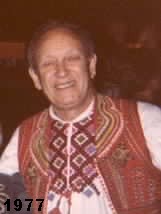|
Vyts Beliajus
|
|
CLICK AN IMAGE FOR LARGER VIEW
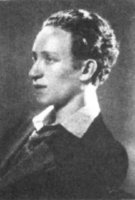 Vytautas Finadar Beliajus was known as "Vyts" to his many, many friends, acquaintances, and his adopted American Indian family. His interest in folk dancing came naturally to him in his native "kaimas" of Pakumprys, Lithuania, where he was born on February 26, 1908. (A kaimas consisted of an area where farmers lived with their lands around their homes. It did not have churches or stores, which were located in townlets, known as "baznytkaimai.") His father was away most of the time "fighting a war." His mother worked the land of an estate owner to survive, while his grandmother, known to him as močiutė, cared for him and his two younger brothers, Leonas and Julius.
Vytautas Finadar Beliajus was known as "Vyts" to his many, many friends, acquaintances, and his adopted American Indian family. His interest in folk dancing came naturally to him in his native "kaimas" of Pakumprys, Lithuania, where he was born on February 26, 1908. (A kaimas consisted of an area where farmers lived with their lands around their homes. It did not have churches or stores, which were located in townlets, known as "baznytkaimai.") His father was away most of the time "fighting a war." His mother worked the land of an estate owner to survive, while his grandmother, known to him as močiutė, cared for him and his two younger brothers, Leonas and Julius.
His immediate family was not religious in the full sense of the term. Rather, they were traditionalists, finding beauty in preparing and observing holidays and traditions in general. Vyts' mother was a folk song leader and had committed to memory dozens of songs in a half dozen languages in a period when there were no radios or television. Vyts said that he remembered all the traditions he encountered in later life, regardless of whose they may have been and that is how he learned his folk dances.
When the war between the Russians and Germans reached his part of Lithuania, the family was forced to flee. In Stakliskes, he contracted small pox, but had to move on. In Butrimonys, the family was allowed to find shelter from the rain under an oak tree in a yard, where Vyts was expected to die overnight. That he didn't is a testiment to his fortitude in the face of health problems that would plague him (no pun intended) throughout his life. Later, in Pivasiunai, the Germans overtook the family and they were sent back to Pakumprys, where they found trenches over their cultivated farms and isolated graves of fallen soldiers around their house.
Vyts mother was determined that he obtain an education and handed him over to a tutor, whom she paid with eggs, grains, chickens, or vegetables. There being no movie theaters, bowling alleys, tennis courts, or golf courses, all of the recreation was related to folk dance, folk song, and folklore. The local Jewish synagogue, Eastern Orthodox church, and Protestant German kirche served as gathering places, not only for the devout, but for the exchange of folk dances and folk ways. He finally got to the small town ("miestelis") of Kaunaas in 1922, eventually becoming aware of such nations as Russia, Germany, China, and the United States of America. The book that opened his eyes to the greater world was Jules Verne's Trip Around the World in 80 Days, translated into Lithuanian.
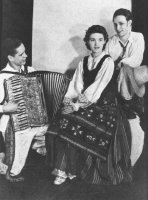 Vyts, accompanying his 85-year-old grandmother, came to the United States on September 3, 1923, at the age of 14, leaving behind his mother and two brothers (a sister, Gyte Jekentes, was born after he left Lithuania). He arrived without the benefit of knowing the English language, but did bring along his Jules Verne book from which he derived his thirst for meeting people of other cultures. After a week's detention at Ellis Island, they headed for Chicago, Illinois, where he had four aunts, two uncles, and two great uncles. (He was surprised that the American race didn't have red skin as their geography books had said was the color of the potatoes Lithuanians called "Amerikankos.")
Vyts, accompanying his 85-year-old grandmother, came to the United States on September 3, 1923, at the age of 14, leaving behind his mother and two brothers (a sister, Gyte Jekentes, was born after he left Lithuania). He arrived without the benefit of knowing the English language, but did bring along his Jules Verne book from which he derived his thirst for meeting people of other cultures. After a week's detention at Ellis Island, they headed for Chicago, Illinois, where he had four aunts, two uncles, and two great uncles. (He was surprised that the American race didn't have red skin as their geography books had said was the color of the potatoes Lithuanians called "Amerikankos.")
His extended Chicago family, completely Americanized, weren't too proud to have non-English-speaking "greenhorns" for relatives. Because of this, he was rotated among various aunts. He attended school for one year, entering at the third-grade level and being promoted to the sixth and seventh grades. Although he skipped grades, Vyts was able to learn English without much difficulty.
His first job was with the Swiss Embroidery Company walking behind a lengthy embroidery machine watching for and replacing empty spools. Being fluent in German, he could converse with two immigrant girls from Bavaria with whom he worked. His next job was in a fur ship, cleaning dirty fur coats with sawdust and benzine. His third, and final job, was with an automotive mail order establishment, filling out foreigh orders, packing, crating, and stenciling addresses. In 1926, at the age of 18, he was on his own; thereafter his grandmother lived with her daughters.
Almost immediately on arriving in Chicago, he had begun his activities in dance, circulating around the Chicago area in the hope of finding a group where the folk dances he loved were being perpetuated. He began folk dancing at St. George's Auditorium. He then found the programs at the Lithuanian Auditorium and began teaching in 1930. He organized the Lithuanian Youth Society to teach the Lithuanian-Americans the folk dances of their homeland. The Society was asked to perform at the 1933 Chicago World's Fair and became increasingly in demand, appearing in the mid-western states and Canada. It was in Chicago where he first became interested in Mexican, Italian, and Hindi dances and culture. He spent ten years learning and performing Hindu solo dances and was the only person in the area to authentically interpret the Hasidic style of dance.
During his youth in Lithuania Vyts did not notice any overt animosity by the Lithuanians against the Germans and, in fact, he was on good terms with German soldiers. One was so pleased at Vyts' reading a story in the Gothic script that he presented Vyts with a chocolate bar, not easily obtainable around 1917 to 1918. In America, however, around 1936, Vyts and a friend, Vytautas Slakis, published an anti-Nazi magazine called Concord. Six issues appeared, but they closed down publication, having received one threat but no community support.
As Vyts' dancers became more and more popular, and his dance books began to appear, he was asked to join the Chicago Park District, teaching folk dances which varied with the ethnic population living around each park, retaining the patterns, music, and meaning of each dance he taught. He began editing one of the first folk dance magazines, Lore Magazine, the precursor to Viltis.
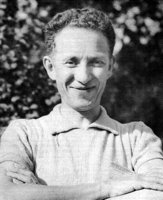 Soon, Vyts was traveling continuously, by 1940 teaching folk dance all over the United States in more than 200 colleges, universities, recreational centers, and other venues. Throughout the years, Vyts left an indelible impression on the psyche of the vast of majority of folk dancers in America.
Soon, Vyts was traveling continuously, by 1940 teaching folk dance all over the United States in more than 200 colleges, universities, recreational centers, and other venues. Throughout the years, Vyts left an indelible impression on the psyche of the vast of majority of folk dancers in America.
The list of Vyt's superlative "firsts" include organization of the first Lithuanian folk dance club in the world in 1933; the first "kolo" (Yugoslavian circle dances) club in the United States to perform before non-ethnic audiences; presented the first folk ballet that combined song, dance, and customs of ethnic authenticity; the first Hindu folk ballet in the United States; the first international folk festival in the southern United States; the first international folk dance teacher to tour Canada; organized the first Israeli group in St. Louis, Missouri; and presented the first ecumenical Easter Passion Play in Fairhope, Alabama.
In 1942, Vyts joined the faculty of the School of Organic Education in Fairhope, Alabama, as a folk dance instructor. In the fall of 1943, he was hospitalized for a tubercular throat, which in those days was treated with "absolute rest" and "fresh air." (Vyts surmised that the long hours using benzine during his job in the fur shop contributed to this condition.) From his bed he maintained correspondence with fellow folk dancers, especially those who were drafted for the war, through hand-written notes that were typed and mimeographed by a friend. By September, 1944, the mimeographed one-pager became a printed four-pager, which he called Viltis ("hope") to express hope that the war would end and that he would be cured. Thus originated the first major international folk dance magazine, devoted to folk customs and arts, especially folk dances, illustrated and printed in English, with a circulation topping 2,500. Vyts was released from institutional care in 1945, but with a barely audible voice.
In 1950, while on a teaching tour of the eastern states, he collapsed and was diagnosed as having tuberculosis throughout his body. At 80 pounds, he was transferred from a Chicago hospital to Denver's Medical Center where he lost his left kidney and much of his hearing. After a long period of recuperation, he moved to San Diego, California, for the milder weather. There, he resumed his typically active program of teaching and presenting folk dances.
In 1952, John Filcich started the California Kolo Festival in San Francisco as a fundraiser for his friend Vyts Beliajus who was ill. Vyts taught several Balkan kolo dances there and started a Balkan dancing craze throughout the country. Vyts was on the staff of the Stockton Folk Dance Camp for 22 years and taught at Kentucky Dance Institute, Maine Folk Dance Camp, Lighted Lantern in Colorado, Texas Folk Dance Camp, Oaxaca (Mexico) Camp, and many others. He made dedicated appearances at such diverse venues as the annual Christmas concert at Brigham Young University in Provo, Utah; Milwaukee’s Holiday Folk Fair; California Folk Federation and Canadian events and others. Vyts also made international junkets.
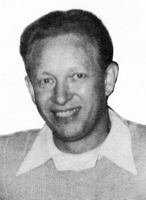 Vyts moved to San Diego, California, for his health. There he formed the Viltis Dancers, mostly from local Lithuanians with a scattering of non-Liths. One of those non-Liths was Dick Oakes, at that time stationed as a medic at the Naval Hospital in Balboa Park.
Vyts moved to San Diego, California, for his health. There he formed the Viltis Dancers, mostly from local Lithuanians with a scattering of non-Liths. One of those non-Liths was Dick Oakes, at that time stationed as a medic at the Naval Hospital in Balboa Park.
In 1958, Vyts moved back to Denver, only to discover he had cancer of the right lung, part of which had to be removed. As soon as he regained his health, he was back on the road, often using assistants to demonstrate what he taught. Denver became his permanent home base where he lived out his life as a respected community member. In the 1970s, he became a member of the executive board of the Colorado Folk Arts Council, serving with Dick Oakes, who had moved to Boulder from Los Angeles for a year and a half. In 1973, Vyts brought international folk dancing to tiny Gilpin County, Colorado, when he taught a group of novice folk dancers at the Belvidere Theatre in Central City on Sundays. In 1986, Vyts was one of the four people who formed the National Folk Organization (NFO).
During his travels, Vyts preferred traveling by bus or train. He said that in case of an accident, you are still in the ground and have a greater chance of survival. But he also never owned or drove a car, saying that he was not mechanically inclined. Such inconveniences, however, he easily overcame.
Brigham Young University paid for Vyts' trip to join the BYU Folk Dance Ensemble on their performance tour of France, Greece, Israel, and Spain. However, Vyts never went abroad strictly for the purpose of collecting or authenticating folk dances. He also felt that discovering new folk dances was a questionable undertaking. As he once said, "The natives of some lands see the researching American coming, and for a dinar, or drachma, or whatever the monetary unit might be, they'll 'discover' a new dance even if it takes all night to figure one out." Vyts choreographed some of his dances for folk dance purposes which are still performed at Lithuanian festivals. These include Dzūkų Polka, Ožiukai, Prienu, Suktute, Vēdaras, and Vestuvių Polka, . . . old forms with variants.
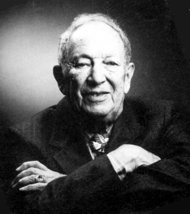 Vyts received certificates of appreciation from the American Legion, Western Illinois University, the "Kolo Festival" in San Francisco (Vyts is credited with starting the "kolomania" dance craze after introducing eight kolos in 1951), and numerous other civic and cultural organizations in the United States. In 1972, Vyts was given the prestigeous AAHPHER (American Association for Health, Physical Education, and Recreation) National Dance Association "Heritage Award," joining such luminaries as Miriam Lidster and Michael & Mary Ann Herman. He was written about in the Lithuanian Encyclopedia, Best Known Lithuanians in the United States, History of Lithuanians in Chicago, and Arte Lituano. He is also listed in Who's Who in the West, Personalities in America, Dictionary of International Biographies, Men of Achievement, and Colorado Who's Who. The Indian Encyclopedia mentioned Viltis because in the early days Vyts frequently published news about Indians and their activites (at the time, there were no Indian newspapers to speak of). When Vyts' Indian niece, Mohota (Morningstar) Ordunez Adams died, she left three orphaned children, Sammy, Hiawatha, and Geronimo. Years later, Geronimo Wayne Adams asked to live with his uncle Vyts, and on October, 1985, he moved in. Then, the Friday before Christmas the same year, the state of Colorado declared Vyts an acceptable father and Geronimo became Vyts' foster son.
Vyts received certificates of appreciation from the American Legion, Western Illinois University, the "Kolo Festival" in San Francisco (Vyts is credited with starting the "kolomania" dance craze after introducing eight kolos in 1951), and numerous other civic and cultural organizations in the United States. In 1972, Vyts was given the prestigeous AAHPHER (American Association for Health, Physical Education, and Recreation) National Dance Association "Heritage Award," joining such luminaries as Miriam Lidster and Michael & Mary Ann Herman. He was written about in the Lithuanian Encyclopedia, Best Known Lithuanians in the United States, History of Lithuanians in Chicago, and Arte Lituano. He is also listed in Who's Who in the West, Personalities in America, Dictionary of International Biographies, Men of Achievement, and Colorado Who's Who. The Indian Encyclopedia mentioned Viltis because in the early days Vyts frequently published news about Indians and their activites (at the time, there were no Indian newspapers to speak of). When Vyts' Indian niece, Mohota (Morningstar) Ordunez Adams died, she left three orphaned children, Sammy, Hiawatha, and Geronimo. Years later, Geronimo Wayne Adams asked to live with his uncle Vyts, and on October, 1985, he moved in. Then, the Friday before Christmas the same year, the state of Colorado declared Vyts an acceptable father and Geronimo became Vyts' foster son.
In 1994, Vyts received the Colorado Governor's Award for Excellence in the Arts as a "Folk Artist." In the Fall 1994 issue of the Lithuanian Quarterly Journal of Arts and Sciences, Lituanus (Volume 40, No. 3), Marijona Venslauskaité-Boyle in an article titled "A Journey Home," wrote "I consider [the renowned poet, Czeslaw Milosz] a phenomenon, although he might not like that characterization. There are others, in other fields, who are similar phenomena: notably one Vytautas (Vyts) Beliajus – well known in the field of international dance. Vyts publishe[d] . . . Viltis, magazine of international dance, almost singlehandedly. These men are sociological phenomena and so am I."
On September 20, 1994, Vytautas Finidar ("Vyts") Beliajus went to meet his maker at the age of 86, just 4 days before the 50th Viltis Anniversary party. Vyt's International Folk Dance library, an extensive collection of folk dance and folklore materials, was donated to the Special Collections and Archives of the Carson-Brierly Dance Library of the University of Denver's Penrose Library.
In a book review of The International Encyclopedia of Dance (Edited by Selma Jeanne Cohen, Oxford University Press, 6 Volumes, $1,250.00), Glenn Giffin, Denver Post Dance Critic wrote, "Missing are such things as any mention of the Colorado Dance Festival, Vail International Dance Festival or the late Vytautus ("Vyts") Beliajus, who was a force in folk dance circles and a notable teacher. It's obvious there is a need for better regional coverage in the U.S. entries."
Here is a list of some of the honors, awards, and recognitions that Vyts received:
- A wood-carved Mexican eagle emblem by Jose Ibarra, from the Henry Booth Settlement in honor of Chicago (no razed), 1936.
- A 200-year-old painting of Our Lady of Guadalupe, presented by Dorothy Gallagher of the Guadalupe Center, Kansas City, Missouri, 1939.
- American Legion, Don Varnas Post (Lithuanian), Chicago, Illinois, 1944.
- Cleveland Sesquicentennial, May 25, 1947.
- Best Polka Dancer, California State Fair, July 1949.
- Prepared French dances and a skit for the 250th Anniversary of the Founding of Cahokia, near St. Louis, Missouri, by French voyagers, May 1949. (He was seated at the same table with Governor Adlai Stevenson of Illinois, His Imminence Samuel Cardinal Stritch, and other dignitaries. Received a personal blessing from the cardinal.)
- Vyts' San Diego Viltis Dancers received the Disneyland Award, 1957.
- Blessing from Pope Pius, 1955.
- Blessing from Pope John Paul on Vyts' 80th birthday, February 26, 1988.
- American Association for Health, Physical Education, Recreation and Dance (AAHPERD) Award, Houston, TX, 1972.
- Brigham Young University Folk Dancers, Provo, Utah, 1972.
- Presented with a portrait of himself, Logan State University, Logan, Utah.
- Yugoslav Kolo Festival, San Francisco, California, November 27, 1970.
- Arizona University Folk Dancers, April 19, 1979.
- Colorado Folk Arts Council, October 24, 1984.
- Free World Lithuanian Folk Festival, Chicago, Illinois, July 7, 1980.
- Balzekas Museum of Lithuanian Culture, July 7, 1980.
- Free World Lithuanian Festival, Hamilton, Canada, July 3, 1988.
- Western Illinois University, Macomb, Illinois, October 1973.
- Kentucky Dance Institute, August, 1988.
- San Antonio College, San Antonio, Texas, March 1988.
- Vyts' name installed on the Wall of Honor, Ellis Island Immigrant Museum, New York.
- Citation for Citizenship Award, Denver, Colorado, 1990.
- Mahirisher Award, Denver, Colorado, September 26, 1981.
- Totem Folk Dancers, Tacoma, Washington, March 9, 1992.
- Special corsage as Guest of Honor at the luncheon given by Emperor of Japan's brother, Prince Takahito Miksa, Tokyo, Japan, November 1986.
- The Minister of Culture and Education of the Republic of Lithuania, the Honorable Darius Kuolys, presented Vyts with a citation, in Vilnius, Lithuania, for his dedication in preserving and spreading the Lithuanian folk dance and traditions among American-born Lithuanian youth, and among non-Lithuanians, June, 1992.
- 1992 Good Neighbor Award from the Capitol Hill Neighborhoods (CHUN), Denver, Colorado, January 12, 1992.
- Honored at the 60th Anniversary of folk dancing at the International House, University of Chicago, April 27, 1993.
- Brigham Young University, Provo, Utah, established a VILTIS – Vyts Scholarship in the folk dance department.
Vyts was also acknowledged in the following:
- "Best-Known Lithuanians"
- "Arte Lituano" (in Spanish, Colombia, South America)
- "Folk Dance USA"
- "Lithuanians Encyclopedia," Lithuanian and English editions
- American Immigrants and their Generation"
- "Who's Who"
- "Community Leaders USA"
Vyts was a prolific writer. Among his publications are
- Concord. 1937. Chicago. Vytautas F. Beliajus. An anti-Nazi, anti-intolerance magzine.
- Dance and Be Merry, Vol. 1. Chicago: Clayton F. Summy Co., By Finadar Vytautas Beliajus. 1941. International folk dance collection.
- Dance and Be Merry, Vol. 2. Chicago: Clayton F. Summy Co., By Finadar Vytautas Beliajus. 1942. International folk dance collection.
- Dance of Lietuva, The. Chicago: Clayton F. Summy Co., 1951. The first book in English of a collection of 54 circle and folk dances from Lithuania, collected and described by Finadar Vytautas Beliajus. Instructions for 54 dances, and material about Lithuania.
- Evening Song, The: Vakarinee Daina. Los Angeles: Bonnie Press, 1954 (revised in 1992). The first book in English of a collection of Lithuanian folk tales, legends and fables, compiled and translated by Vytautas F. Beliajus. Illustrated by Louis Denov.
- "Jugoslav – Serbia Costume." Viltis, V, No. 11 (1948).
- Khanukkah, a Holiday Jolly. Denver: V.F. Beliajus, 1955 (revised 1974). A.D. Nix. Co. History, a skit, songs, and dances.
- Let's Be Merry (Linksmi Beukim). Delaware, Ohio: Cooperative Recreation Service, 1951, 38p. Beliajus, Vytautas Finadar. Lithuanian folk songs in original and Lithuanian languages, games, legends, folk dances.
- Lore. Chicago, Ill.: Chicago Park System. A folklore magazine published by Vyts Beliajus, 1936-1939. The first folklore magazine devoted to folk dance and described by Mr. Beliajus as "sort of like a forerunner of VILTIS," was published with WPA money.
- Merrily Dance. Delaware, Ohio: Cooperative Recreation Service, 1947 (revised in 1955), 24 p. Instructions and music for 12 dances by Vyts Beliajus.
- Ona. Denver: A.D. Nix, 1977. By Vytautas F. Beliajus; illustrations by Gloria Ptacek Andersson. A collection of short stories of Lithuania. Cover art by Gloria Ptaicek Anderson, cover graphic by Louis Denov.
- Palestine Makes Merry. In preparation when Vyts died.
- Svieka Marija – Ave Maria. Denver: 1968. By Vytautas F. Beliajus; Original composition by Vyts Beliajus. Arranged by Lizúdas Stukas. Music and text in Lithuanian and Latin. Cover art by Dick Oakes.
- They Still Do It. In preparation when Vyts died.
- Vaga – The Furrow. 1935. By Vytautas F. Beliajus. First book in English of short stories and poetry by Lithuanian youth.
- Viltis. A folklore and dance magazine, published by Vyts Beliajus from 1942 to 1944 as a mimeographed armed-services newsletter, then as a printed publication from September, 1944 to Mr. Beliajus' death in 1994, when its publication was assumed by the International Institute of Milwaukee, Wisconsin. Available on microfilm from Xerox's University Microfilms, Serials Dept., 300 N. Zeep Rd., Ann Arbor, MI 48106.
- Viltis Foods of the World. Denver: V.F. Beliajus, 1973, 98p. Compiled by Vytautas Finadar Beliajus.
- Where the Nemunas Flows. In preparation when Vyts died.
Some of Vyts credits include:
- Vyts organized the first Lithuanian folk dance group in the world, the Lithuanian Youth Society, 1933.
- Vyts was the first to teach international folk dancing as a recreation for the public at the International House of the University of Chicago, 1935.
- Vyts sponsored the largest Lithuanian art display, fine and folk, in downtown Chicago, 1936.
- Vyts presented the first large-scale out-door Lithuanian St. John's Festival, seen by thousands, Mark White Square, Chicago's Marquette Park, 1939 and 1940. This group represented Lithuanians in Washington, D.C.; Cleveland, Ohio; St. Louis, Missouri; and elsewhere.
- Vyts' Ateitis Lithuanian Folk Dance Group represented the USA at a week-long festival in Toronto, Ontario, Canada.
- Vyts worked for the Chicago Park System, teaching folk dance to ethnic groups in their neighborhood parks (Czechoslovakian, Hungarian, Jewish, Lithuanian, Mexican, Polish, and Yugoslav).
- Vyts published "Lore," a folk dance magazine for the Chicago Park System.
- Vyts presented many original, first-of-their-kind, folk ballets that included acting, dance, and song (Hindu, Jewish, Lithuanian, Mexican, and Polish).
Dances Vyts taught include
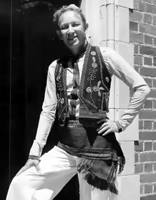 Adarim,
Aguonēlē,
Alabama Gal,
Alexandrovska,
Angus Reel Mixer,
Audejēlē,
Aupres de Ma Blonde,
Baile da Kamacha,
Bal del Truc,
Ballo Sardo (Ballo Tondo),
Baroiges Tanz,
Bear Came Over the Mountain,
Bekedorfer Quadrille,
Bellendans (Jingle Bells),
Biały Mazur,
Bimtsaltayim - R'Kod Hat'Laim (Dance of the Flocks),
Bingo,
Bleking,
Blezdingele,
Bona Habanot,
Boulangère,
Bow Belinda,
Braid,
Bridge of Avignon,
Bufčansko,
Cake Walk Singing Circle,
Čamče,
Camino al Baño,
Captain Jinks,
Caraway and Cheese,
Carousel,
Castill ter Sol,
Chamarita,
Cherkessia,
Chirvony Pas,
Cigansko horo,
Circassian Circle,
Circle Debka,
Clawd Offa,
Comin' 'Round the Mountain,
Crested Hen,
Csárdás,
Csebogar,
D'Hammerschmiedsg'selln,
Danish Schottische,
Debka Horra,
Den Lille Vendlebo,
Džangurca,
Dzūkų Polka,
Dzukų Polka,
Eightsome Reel,
Ennstaler Polka,
Espunyolet,
Fado for Fours,
Family Rheinlander,
Fireman's Dance,
Frydasdal Polska,
Gaida,
Gaida Gidas,
Galopede,
Garçon Volage,
Gathering Peascods,
Go 'Round and 'Round the Village,
Good Old Days,
Gosti Vikaja,
Grand Circle,
Greiž (Grečius),
Gretel's Carousel,
Grosse Runde,
Haj Narodno horo,
Hanske van Leuven,
Harmonica,
Hassidic Sher,
Hava Netze Be'mahol,
Heeia,
Helena Polka,
Heney Lo Yanum,
Here We Go Around the Mulberry Bush,
Hiers ek Weer,
Highland Schottische,
Hiney lo Yanum,
Histoveivi,
Horra,
Hora Arabi,
Hora de la Balţi,
Horra Halutsit,
Hrechaniki,
Hunting We Will Go,
Il Codiglione,
Imk Į Ratą,
Incachu,
I Want To Be a Farmer,
Jandals,
Jarabe Tapatío,
Jarabe Tlaxcalteco,
Jaunimélis,
Jievaro Tiltas,
Jig Arglwydd Caernarfon,
Jig Esgob Bangor,
Jingle at the Window,
Jingle Bells,
Jocul de-a Lungul,
Jo Estet Kivanok,
Jonkelis,
Juanimēlis,
Jump Josie Jump,
Jurgelis,
Kalvelis,
Karanfile,
Karapiet (Tsigonochka),
Karrarod,
Kashubian Walc,
Kastorianos Syrtos,
Khevrayah,
Kiškelis,
Klumpakojis,
Knud Jepsen's Vals,
Koja Koja,
Kokietka,
Kokotek,
Korobushka,
Kostursko oro
Krakowiak,
Kūbilas,
Kujawiak,
Kuma Echa,
Kupolēes,
La Boulangere,
La Burrita,
La Furlana,
La Lavandera,
La Mazurca Mexicana,
La Palomita,
La Robe Du Chat,
La Varsouvianna,
Lamb's Fold,
Las Espuelas,
Lenciūgēlis,
Liokšinis,
Little Man In a Fix,
Macheteros,
Makedonka,
Malaguena a lo Canario,
Malūnas,
Malūnelis,
Mamer,
Marioara,
Mason's Apron,
Meillionen Cylch,
Meillionen o Ferionydd,
Menuetwaltzer,
Midsummer Night's Dream,
Mikita,
Mikitukas,
Moeder Wies,
Moskroser,
Moteru, Mikita,
Napoleon,
Našlys,
Neda Grivne,
Neu Bayerisch,
Nevestinsko horo,
Nigun,
Noriu Miego,
Nyth y Gog,
Old Southern Schottische,
Ova's Dam,
Oxo,
Oyda,
Ožiukai,
Pa'am Achat,
Pajduško horo,
Palpankili,
Pant Corlan yr Wyn,
Pas d'Espan,
Passe Pied de Carhaix,
Patch Tanz,
Paw Paw Patch,
Petersen,
Phililppine Couple Dance,
Plum Picker's Waltz,
Polka Piquée,
Polka Wengierka,
Pop Goes the Weasel,
Pop Marinko,
Portland Fancy,
Pretty Maidens,
Prienu Suktuté,
Quagriglia di Aviano,
Quadriglia Italiana,
R'Kod Ha'Talyim,
R'Kod Hat'Laim,
Radikalka,
Ratukas (Raatiko, Radiko),
Retežēlis,
Retchenko,
Rheinlander Polka,
Rig a Jig Jig Mixer,
Rijpe (Riipe) Gerst,
Ritka Buza,
Robin Ddiog,
Ropogos,
Rugučiai,
Rutelē,
Salterello di Romagna,
Sandyland,
Sardana,
Sedmalinas,
Seven Jumps,
Shake Them 'Simmons Down,
Sham B'Eretz Israel,
Sheena,
Sheikhani,
Sher,
Sherele,
Sicilian Tarantella,
Šimas,
Simmons,
Simi Yadech,
Siuntē,
Skating Away,
Skeptinē,
Soljančica,
Somebody Waiting for Me,
Soultana,
Soyotte Lorraine,
Sudmalinas,
Suktute,
Sukčius (The Cheat),
Sukčius (The Turner),
Suktinis,
Sur la Bord de la Rivieŕe,
Šustas,
Swedish Weaving Dance,
Syrtos,
Syrtos Kefallanias,
Syrtos Rodou,
'Tant Hessie,
Tarantella Montevergine,
Thady You Gander,
Three Meet,
Timonia,
Toi Nergis,
To Ting,
Triolet,
Trip to Helsinki,
Troika,
Tsarina de la Abrud,
Umarl Mačiek,
Uodas,
Valamit Sugok Maganak,
Vals Sekstur,
Varsouvienne,
Ve David,
Vēdaras (The Pudding),
Velykodnya Hayirka,
Vengierka I,
Vengierka II,
Vestių Polka,
Vestuvių Polka,
Vetter Michel,
Village Krakowiak,
Voveraitē,
Vranjanka,
Wesele u Witosa,
Western Promenade Trio,
We Won't Go Home Till Morning,
Windmueller,
Women's Mikita,
Wrth Fynd Efo Deio i Dwyn,
Yankee Doodle Mixer,
Yan Petit,
Yemina Yemina,
Yesusun mi Dbar,
Yoterort Kogheen Bar ("Dance of the Seventh Veil"),
Žakle Šivajo (Žakli),
Zasiali Gorale,
Zhuravel,
Zigeunerpolka,
Žikino,
Žiogelis,
Žilvytis,
and
Žvirblis.
Adarim,
Aguonēlē,
Alabama Gal,
Alexandrovska,
Angus Reel Mixer,
Audejēlē,
Aupres de Ma Blonde,
Baile da Kamacha,
Bal del Truc,
Ballo Sardo (Ballo Tondo),
Baroiges Tanz,
Bear Came Over the Mountain,
Bekedorfer Quadrille,
Bellendans (Jingle Bells),
Biały Mazur,
Bimtsaltayim - R'Kod Hat'Laim (Dance of the Flocks),
Bingo,
Bleking,
Blezdingele,
Bona Habanot,
Boulangère,
Bow Belinda,
Braid,
Bridge of Avignon,
Bufčansko,
Cake Walk Singing Circle,
Čamče,
Camino al Baño,
Captain Jinks,
Caraway and Cheese,
Carousel,
Castill ter Sol,
Chamarita,
Cherkessia,
Chirvony Pas,
Cigansko horo,
Circassian Circle,
Circle Debka,
Clawd Offa,
Comin' 'Round the Mountain,
Crested Hen,
Csárdás,
Csebogar,
D'Hammerschmiedsg'selln,
Danish Schottische,
Debka Horra,
Den Lille Vendlebo,
Džangurca,
Dzūkų Polka,
Dzukų Polka,
Eightsome Reel,
Ennstaler Polka,
Espunyolet,
Fado for Fours,
Family Rheinlander,
Fireman's Dance,
Frydasdal Polska,
Gaida,
Gaida Gidas,
Galopede,
Garçon Volage,
Gathering Peascods,
Go 'Round and 'Round the Village,
Good Old Days,
Gosti Vikaja,
Grand Circle,
Greiž (Grečius),
Gretel's Carousel,
Grosse Runde,
Haj Narodno horo,
Hanske van Leuven,
Harmonica,
Hassidic Sher,
Hava Netze Be'mahol,
Heeia,
Helena Polka,
Heney Lo Yanum,
Here We Go Around the Mulberry Bush,
Hiers ek Weer,
Highland Schottische,
Hiney lo Yanum,
Histoveivi,
Horra,
Hora Arabi,
Hora de la Balţi,
Horra Halutsit,
Hrechaniki,
Hunting We Will Go,
Il Codiglione,
Imk Į Ratą,
Incachu,
I Want To Be a Farmer,
Jandals,
Jarabe Tapatío,
Jarabe Tlaxcalteco,
Jaunimélis,
Jievaro Tiltas,
Jig Arglwydd Caernarfon,
Jig Esgob Bangor,
Jingle at the Window,
Jingle Bells,
Jocul de-a Lungul,
Jo Estet Kivanok,
Jonkelis,
Juanimēlis,
Jump Josie Jump,
Jurgelis,
Kalvelis,
Karanfile,
Karapiet (Tsigonochka),
Karrarod,
Kashubian Walc,
Kastorianos Syrtos,
Khevrayah,
Kiškelis,
Klumpakojis,
Knud Jepsen's Vals,
Koja Koja,
Kokietka,
Kokotek,
Korobushka,
Kostursko oro
Krakowiak,
Kūbilas,
Kujawiak,
Kuma Echa,
Kupolēes,
La Boulangere,
La Burrita,
La Furlana,
La Lavandera,
La Mazurca Mexicana,
La Palomita,
La Robe Du Chat,
La Varsouvianna,
Lamb's Fold,
Las Espuelas,
Lenciūgēlis,
Liokšinis,
Little Man In a Fix,
Macheteros,
Makedonka,
Malaguena a lo Canario,
Malūnas,
Malūnelis,
Mamer,
Marioara,
Mason's Apron,
Meillionen Cylch,
Meillionen o Ferionydd,
Menuetwaltzer,
Midsummer Night's Dream,
Mikita,
Mikitukas,
Moeder Wies,
Moskroser,
Moteru, Mikita,
Napoleon,
Našlys,
Neda Grivne,
Neu Bayerisch,
Nevestinsko horo,
Nigun,
Noriu Miego,
Nyth y Gog,
Old Southern Schottische,
Ova's Dam,
Oxo,
Oyda,
Ožiukai,
Pa'am Achat,
Pajduško horo,
Palpankili,
Pant Corlan yr Wyn,
Pas d'Espan,
Passe Pied de Carhaix,
Patch Tanz,
Paw Paw Patch,
Petersen,
Phililppine Couple Dance,
Plum Picker's Waltz,
Polka Piquée,
Polka Wengierka,
Pop Goes the Weasel,
Pop Marinko,
Portland Fancy,
Pretty Maidens,
Prienu Suktuté,
Quagriglia di Aviano,
Quadriglia Italiana,
R'Kod Ha'Talyim,
R'Kod Hat'Laim,
Radikalka,
Ratukas (Raatiko, Radiko),
Retežēlis,
Retchenko,
Rheinlander Polka,
Rig a Jig Jig Mixer,
Rijpe (Riipe) Gerst,
Ritka Buza,
Robin Ddiog,
Ropogos,
Rugučiai,
Rutelē,
Salterello di Romagna,
Sandyland,
Sardana,
Sedmalinas,
Seven Jumps,
Shake Them 'Simmons Down,
Sham B'Eretz Israel,
Sheena,
Sheikhani,
Sher,
Sherele,
Sicilian Tarantella,
Šimas,
Simmons,
Simi Yadech,
Siuntē,
Skating Away,
Skeptinē,
Soljančica,
Somebody Waiting for Me,
Soultana,
Soyotte Lorraine,
Sudmalinas,
Suktute,
Sukčius (The Cheat),
Sukčius (The Turner),
Suktinis,
Sur la Bord de la Rivieŕe,
Šustas,
Swedish Weaving Dance,
Syrtos,
Syrtos Kefallanias,
Syrtos Rodou,
'Tant Hessie,
Tarantella Montevergine,
Thady You Gander,
Three Meet,
Timonia,
Toi Nergis,
To Ting,
Triolet,
Trip to Helsinki,
Troika,
Tsarina de la Abrud,
Umarl Mačiek,
Uodas,
Valamit Sugok Maganak,
Vals Sekstur,
Varsouvienne,
Ve David,
Vēdaras (The Pudding),
Velykodnya Hayirka,
Vengierka I,
Vengierka II,
Vestių Polka,
Vestuvių Polka,
Vetter Michel,
Village Krakowiak,
Voveraitē,
Vranjanka,
Wesele u Witosa,
Western Promenade Trio,
We Won't Go Home Till Morning,
Windmueller,
Women's Mikita,
Wrth Fynd Efo Deio i Dwyn,
Yankee Doodle Mixer,
Yan Petit,
Yemina Yemina,
Yesusun mi Dbar,
Yoterort Kogheen Bar ("Dance of the Seventh Veil"),
Žakle Šivajo (Žakli),
Zasiali Gorale,
Zhuravel,
Zigeunerpolka,
Žikino,
Žiogelis,
Žilvytis,
and
Žvirblis.
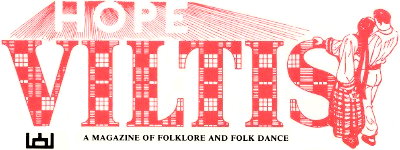
|
Viltis Golden Anniversary 1944 to 1994
On September 24, 1994, the Viltis 50 Golden Anniversary 1944 to 1994 Program was held in Denver, Colorado. Here is that program and a picture of Rudy Ulibarri, singing the Twenty-Third Psalm, and Vyts Beliajus, interpreting the psalm in dance.
CLICK AN IMAGE FOR LARGER VIEW
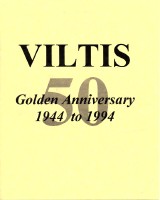
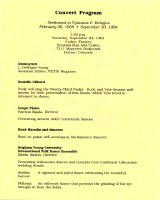
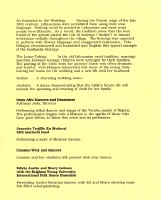
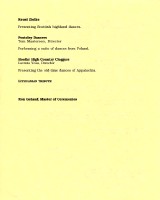
|
50th Anniversary Program
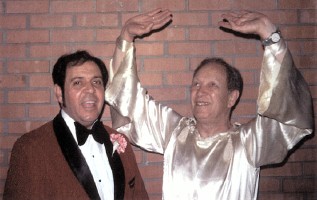
Rudy Ulibarrí sings the Twenty-Third Psalm |
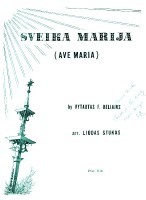
The Sveika Marija (Ave Maria) |
